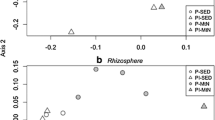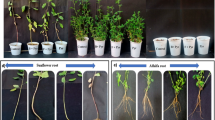Abstract
The present study is aimed to develop a microbial system for efficient naphthalene bioremediation. A phytotoxicity study was carried out to check the naphthalene detoxification efficiency of Pseudomonas sp. strain SA3 in mung bean (Vigna radiata). For this, administration of the degraded product (supernatant) of 500 mg L−1 naphthalene by Pseudomonas sp. strain SA3 was studied on V. radiata till 168 h. The growth parameters of mung bean seedlings exposed to treated naphthalene solution were statistically similar to distilled water but a twofold decrease when exposed to untreated naphthalene solution. Further, through the soil microcosm study, the naphthalene degradation by pure colonies of Pseudomonas sp. strain SA3 was 6.8% higher as compared to when the natural microflora was mixed with Pseudomonas sp. strain SA3. Further naphthalene degradation by a microcosm model revealed that with an increased concentration of glucose, the carbon dioxide trap rate decreases.









Similar content being viewed by others
Data availability
Experimental data could be provided on appropriate request.
References
Agah H, Mehdinia A, Bastami KD, Rahmanpour S (2017) Polycyclic aromatic hydrocarbon pollution in the surface water and sediments of Chabahar Bay, Oman Sea. Mar Pollut Bull 115:515e524. https://doi.org/10.1016/j.marpolbul.2016.12.032
Ahammed GJ, Gao CJ, Ogweno JO, Zhou YH, Xia XJ, Mao WH, Shi K, Yu JQ (2012) Brassinosteroids induce plant tolerance against phenanthrene by enhancing degradation and detoxification in Solanum lycopersicum L. Ecotoxicol Environ Saf 80:28–36. https://doi.org/10.1016/j.ecoenv.2012.02.004
Aravind P, Selvaraj H, Ferro S, Sundaram M (2016) An integrated (electro-and bio-oxidation) approach for remediation of industrial wastewater containing azo-dyes: understanding the degradation mechanism and toxicity assessment. J Hazard Mater 318:203–215. https://doi.org/10.1016/j.jhazmat.2016.07.028
Arias L, Bauzá J, Tobella J, Vila J, Grifoll M (2008) A microcosm system and an analytical protocol to assess PAH degradation and metabolite formation in soils. Biodegradation 19(3):425–434. https://doi.org/10.1007/s10532-007-9148-0
Baek KH, Kim HS, Oh HM, Yoon BD, Kim J, Lee IS (2004) Effects of crude oil, oil components, and bioremediation on plant growth. J Environ Sci Heal A 39(9):2465–2472. https://doi.org/10.1081/ESE-200026309
Bagi A, Pampanin DM, Lanzén A, Bilstad T, Kommedal R (2014) Naphthalene biodegradation in temperate and arctic marine microcosms. Biodegradation 25(1):111–125. https://doi.org/10.1007/s10532-013-9644-3
Barman S, Banerjee P, Mukhopadhayay A, Das P (2017) Biodegradation of acenapthene and naphthalene by Pseudomonas mendocina: process optimization, and toxicity evaluation. J Environ Chem Eng 5(5):4803–4812. https://doi.org/10.1016/j.jece.2017.09.012
Cavalca L, Colombo M, Larcher S, Gigliotti C, Collina E, Andreoni V (2002) Survival and naphthalene-degrading activity of Rhodococcus sp. strain 1BN in soil microcosms. J Appl Microbiol 92(6):1058–1065. https://doi.org/10.1046/j.1365-2672.2002.01640.x
Cseke LJ, Kirakosyan A, Kaufman PB, Warber S, Duke JA, Brielmann HL (2016) Natural products from plants. CRC Press, Boca Raton
Dave BP, Ghevariya CM, Bhatt JK, Dudhagara DR, Rajpara RK (2014) Enhanced biodegradation of total polycyclic aromatic hydrocarbons (TPAHs) by marine halotolerant Achromobacter xylosoxidans using Triton X-100 and β-cyclodextrin—a microcosm approach. Mar Pollut Bull 79(1–2):123–129. https://doi.org/10.1016/j.marpolbul.2013.12.027
Filonov AE, Puntus IF, Karpov AV, Kosheleva IA, Kashparov KI, Slepenkin AV, Boronin AM (2004) Efficiency of naphthalene biodegradation by Pseudomonas putida G7 in soil. J Chem Tech Biotechnol Int Res Process Environ Technol 79(6):562–569. https://doi.org/10.1002/jctb.998
Gerhardt KE, Huang XD, Glick BR, Greenberg BM (2009) Phytoremediation and rhizoremediation of organic soil contaminants: potential and challenges. Plant Sci 176(1):20–30. https://doi.org/10.1016/j.plantsci.2008.09.014
Germaine KJ, Keogh E, Ryan D, Dowling DN (2009) Bacterial endophyte-mediated naphthalene phytoprotection and phytoremediation. FEMS Microbiol Lett 296(2):226–234. https://doi.org/10.1111/j.1574-6968.2009.01637.x
González-Gaya B, Fernández-Pinos MC, Morales L, Méjanelle L, Abad E, Piña B, Duarte CM, Jiménez B, Dachs J (2016) High atmosphere–ocean exchange of semivolatile aromatic hydrocarbons. Nat Geosci 9(6):438–442. https://doi.org/10.1038/ngeo2714
Hernández-Adame NM, López-Miranda J, Martínez-Prado MA, Cisneros-de la Cueva S, Rojas-Contreras JA, Medrano-Roldán H (2021) Increase in total petroleum hydrocarbons removal rate in contaminated mining soil through bioaugmentation with autochthonous fungi during the slow bioremediation stage. Water Air Soil Pollut 232(3):1–15. https://doi.org/10.1007/s11270-021-05051-0
Hossain MS, Fakhruddin ANM, Chowdhury MAZ, Gan SH (2016) Impact of ship-breaking activities on the coastal environment of Bangladesh and a management system for its sustainability. Environ Sci Policy 60:84–94. https://doi.org/10.1016/j.envsci.2016.03.005
Jia C, Batterman S (2010) A critical review of naphthalene sources and exposures relevant to indoor and outdoor air. Int J Environ Res Public Health 7(7):2903–2939. https://doi.org/10.3390/ijerph7072903
Karishma M, Trivedi VD, Choudhary A, Mhatre A, Kambli P, Desai J, Phale PS (2015) Analysis of preference for carbon source utilization among three strains of aromatic compounds degrading Pseudomonas. FEMS Microbiol Lett 362(20):fnv139. https://doi.org/10.1093/femsle/fnv139
Kuiper I, Bloemberg GV, Lugtenberg BJ (2001) Selection of a plant–bacterium pair as a novel tool for rhizostimulation of polycyclic aromatic hydrocarbon-degrading bacteria. Mol Plant Microbe Interact 14(10):1197–1205. https://doi.org/10.1094/MPMI.2001.14.10.1197
Kummerová M, Krulová J, Zezulka Å, Tříska J (2006) Evaluation of fluoranthene phytotoxicity in pea plants by Hill reaction and chlorophyll fluorescence. Chemosphere 65(3):489–496. https://doi.org/10.1016/j.chemosphere.2006.01.052
Lipińska A, Wyszkowska J, Kucharski J (2021) Microbiological and biochemical activity in soil contaminated with pyrene subjected to bioaugmentation. Water Air Soil Pollut 232(2):1–18. https://doi.org/10.1007/s11270-020-04950-y
Liu H, Weisman D, Ye YB, Cui B, Huang YH, Colón-Carmona A, Wang ZH (2009) An oxidative stress response to polycyclic aromatic hydrocarbon exposure is rapid and complex in Arabidopsis thaliana. Plant Sci 176(3):375–382. https://doi.org/10.1016/j.plantsci.2008.12.002
Megharaj M, Ramakrishnan B, Venkateswarlu K, Sethunathan N, Naidu R (2011) Bioremediation approaches for organic pollutants: a critical perspective. Environ Int 37(8):1362–1375. https://doi.org/10.1016/j.envint.2011.06.003
Miyasaka T, Asami H, Watanabe K (2006) Impacts of bioremediation schemes on bacterial population in naphthalene-contaminated marine sediments. Biodegradation 17(3):227–235. https://doi.org/10.1007/s10532-005-5018-9
Neşer G, Kontas A, Ünsalan D, Altay O, Darılmaz E, Uluturhan E, Küçüksezgin F, Tekoğul N, Yercan F (2012) Polycyclic aromatic and aliphatic hydrocarbons pollution at the coast of Aliağa (Turkey) ship recycling zone. Mar Pollut Bull 64(5):1055–1059. https://doi.org/10.1016/j.marpolbul.2012.02.019
Organisation for Economic Cooperation and Development (OCED) (1984) Terrestrial plants, growth test. OCED guidelines for testing of chemicals, vol 208. OECD, Paris
Pathak H, Kantharia D, Malpani A, Madamwar D (2009) Naphthalene degradation by Pseudomonas sp. HOB1: in vitro studies and assessment of naphthalene degradation efficiency in simulated microcosms. J Hazard Mater 166(2–3):1466–1473. https://doi.org/10.1016/j.jhazmat.2008.12.074
Piskonen R, Nyyssönen M, Rajamäki T, Itävaara M (2005) Monitoring of accelerated naphthalene-biodegradation in a bioaugmented soil slurry. Biodegradation 16(2):127–134. https://doi.org/10.1007/s10532-004-4893-9
Roberts AP, Alloy MM, Oris JT (2017) Review of the photo-induced toxicity of environmental contaminants. Comp Biochem Physiol C Toxicol Pharmacol 191:160–167. https://doi.org/10.1016/j.cbpc.2016.10.005
Sampaio CJ, de Souza JR, Damião AO, Bahiense TC, Roque MR (2019) Biodegradation of polycyclic aromatic hydrocarbons (PAHs) in a diesel oil-contaminated mangrove by plant growth-promoting rhizobacteria. 3 Biotech 9(4):1–10. https://doi.org/10.1007/s13205-019-1686-8
Singleton DR, Richardson SD, Aitken MD (2011) Pyrosequence analysis of bacterial communities in aerobic bioreactors treating polycyclic aromatic hydrocarbon-contaminated soil. Biodegradation 22(6):1061–1073. https://doi.org/10.1007/s10532-011-9463-3
Sleight TW, Khanna V, Gilbertson LM, Ng CA (2020) Network analysis for prioritizing biodegradation metabolites of polycyclic aromatic hydrocarbons. Environ Sci Technol 54(17):10735–10744. https://doi.org/10.1021/acs.est.0c02217
Smith MJ, Flowers TH, Duncan HJ, Alder J (2006) Effects of polycyclic aromatic hydrocarbons on germination and subsequent growth of grasses and legumes in freshly contaminated soil and soil with aged PAHs residues. Environ Pollut 141(3):519–525. https://doi.org/10.1016/j.envpol.2005.08.061
Smreczak B, Maliszewska-Kordybach B (2003) Seeds germination and root growth of selected plants in PAH contaminated soil. Fresenius Environ Bull 12(8):946–949
Soner O, Celik E, Akyuz E (2021) A fuzzy best–worst method (BWM) to assess the potential environmental impacts of the process of ship recycling. Marit Policy Manag. https://doi.org/10.1080/03088839.2021.1889066. 1-14
Stokes ME, McCourt P (2014) Towards personalized agriculture: what chemical genomics can bring to plant biotechnology. Front Plant Sci 5:344. https://doi.org/10.3389/fpls.2014.00344
Suja F, Rahim F, Taha MR, Hambali N, Razali MR, Khalid A, Hamzah A (2014) Effects of local microbial bioaugmentation and biostimulation on the bioremediation of total petroleum hydrocarbons (TPH) in crude oil contaminated soil based on laboratory and field observations. Int Biodeterior Biodegrad 90:115–122. https://doi.org/10.1016/j.ibiod.2014.03.006
Swathi KV, Muneeswari R, Ramani K, Sekaran G (2020) Biodegradation of petroleum refining industry oil sludge by microbial-assisted biocarrier matrix: process optimization using response surface methodology. Biodegradation 31(4):385–405. https://doi.org/10.1007/s10532-020-09916-9
Taccari M, Milanovic V, Comitini F, Casucci C, Ciani M (2012) Effects of biostimulation and bioaugmentation on diesel removal and bacterial community. Int Biodeterior Biodegrad 66(1):39–46. https://doi.org/10.1016/j.ibiod.2011.09.012
Teng Y, Luo Y, Sun M, Liu Z, Li Z, Christie P (2010) Effect of bioaugmentation by Paracoccus sp. strain HPD-2 on the soil microbial community and removal of polycyclic aromatic hydrocarbons from an aged contaminated soil. Bioresour Technol 101(10):3437–3443. https://doi.org/10.1016/j.biortech.2009.12.088
Tirkey SR, Ram S, Mishra S (2021) Naphthalene degradation studies using Pseudomonas sp. strain SA3 from Alang-Sosiya ship breaking yard. Gujarat Heliyon 7(3):e06334. https://doi.org/10.1016/j.heliyon.2021.e06334
Wei H, Song S, Tian H, Liu T (2014) Effects of phenanthrene on seed germination and some physiological activities of wheat seedling. C R Biol 337(2):95–100. https://doi.org/10.1016/j.crvi.2013.11.005
Wu M, Dick WA, Li W, Wang X, Yang Q, Wang T, Xu L, Zhang M, Chen L (2016) Bioaugmentation and biostimulation of hydrocarbon degradation and the microbial community in a petroleum-contaminated soil. Int Biodeterior Biodegrad 107:158–164. https://doi.org/10.1016/j.ibiod.2015.11.019
Yu KSH, Wong AHY, Yau KWY, Wong YS, Tam NFY (2005) Natural attenuation, biostimulation and bioaugmentation on biodegradation of polycyclic aromatic hydrocarbons (PAHs) in mangrove sediments. Mar Pollut Bull 51(8–12):1071–1077. https://doi.org/10.1016/j.marpolbul.2005.06.006
Zhou W, He D, Li X, Zhang H, Zeng X, Cheng G (2013) Isolation and characterization of naphthalene-degrading strains, Pseudomonas sp. CZ2 and CZ5. Afr J Microbiol Res 7(1):13–19. https://doi.org/10.5897/AJMR12.494
Zhu X, Liu R, Liu C, Chen L (2015) Bioaugmentation with isolated strains for the removal of toxic and refractory organics from coking wastewater in a membrane bioreactor. Biodegradation 26(6):465–474. https://doi.org/10.1007/s10532-015-9748-z
Zocca C, Di Gregorio S, Visentini F, Vallini G (2004) Biodiversity amongst cultivable polycyclic aromatic hydrocarbon-transforming bacteria isolated from an abandoned industrial site. FEMS Microbiol Lett 238(2):375–382. https://doi.org/10.1111/j.1574-6968.2004.tb09779.x
Acknowledgements
SRT is grateful to University Grant Commission-National Fellowship for Higher Education (UGC-NHFE). SR and MM are thankful to Council of Scientific and Industrial Research (CSIR). Further, SRT, SR and MM would like to acknowledge the Academy of Scientific and Innovative Research (AcSIR) for Ph.D. enrolment.
Funding
This study was funded by UGC-NHFE [F1-17.1/2016-17/NFST-2015-17-ST-JHA-2164] and CSIR-HRDG [31/28(223)2 K-17/EMR-I].
Author information
Authors and Affiliations
Contributions
Conceptualization, Methodology, Software, Formal analysis, Validation, Visualization, Investigation, Data curation, Writing—original draft, Writing—review & editing: SRT. Investigation, Software, Data curation, Formal analysis, Writing—review & editing: SR. Investigation, Data curation Writing—review & editing: MM. Resources, Supervision, Writing—review & editing: SM.
Corresponding author
Ethics declarations
Conflict of interest
No competing interest.
Ethical approval
This article does not contain any studies with human participants or animals performed by any of the authors.
Consent for publication
Not applicable.
Additional information
Publisher’s Note
Springer Nature remains neutral with regard to jurisdictional claims in published maps and institutional affiliations.
Rights and permissions
About this article
Cite this article
Tirkey, S.R., Ram, S., Mitra, M. et al. Performance analysis of Pseudomonas sp. strain SA3 in naphthalene degradation using phytotoxicity and microcosm studies. Biodegradation 33, 169–180 (2022). https://doi.org/10.1007/s10532-022-09972-3
Received:
Accepted:
Published:
Issue Date:
DOI: https://doi.org/10.1007/s10532-022-09972-3




